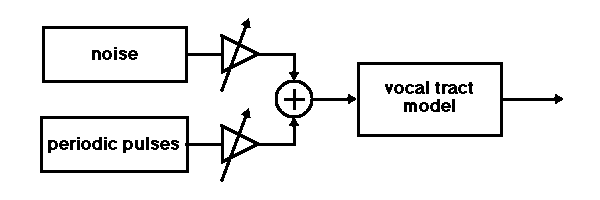|
|
|
|
|
This demo is extracted from Professor Edward Lee's
Home Page
.
|
The rough structure of a speech synthesis model is shown below:

|
|
Introduction
The introduction to the vocoder itself has been processed by the vocoder, demonstrating reasonably good audio quality (by telephone standards, which emphasize intelligibility and speaker recognition over audio fidelity). |
|
Comparison
Here, the vocoder output is compared to uncoded output (over a "public address system"). |
|
Unvoiced speech
Whispered speech is generated by setting the vocoder as if all speech were unvoiced (input to the synthesis filter is only "hiss-type energy"). Below, a plot of voiced speech (top) is compared to a plot of unvoiced speech (bottom) in the time domain. 


|
|
Voiced speech
Mechanical-sounding speech generated by setting the vocoder as if all speech were voiced (input to the synthesis filter is only "buzz-type energy"). |
|
Monotone speech
Here, both voiced and unvoiced sounds are produced, but the voiced sounds are held at a constant pitch, yielding a monotone effect. |
|
Pitch modifications
Here, pitch is modified under the control of a hand dial. |
|
One octave lower
An octave is a factor of two in frequency. In this demonstration, the vocoder halves the pitch of the speaker. |
|
One octave higher
In this demonstration, the vocoder doubles the pitch of the speaker. |
|
Inflection
"Inflection" is the variations in pitch in speech. The vocoder can be set to reduce or increase the inflection without shifting the pitch up or down. |
|
Inflection manipulations on a song
In this demonstration, the inflection reduction and enhancement is demonstrated on a song. |
|
Reversing the inflection
In this demonstration, inflection is reversed. That is, when the pitch of the original speech would be rising, here it is falling, and vice versa. |
|
Special effects sounds
Here, the vocoder is used to synthesize non-speech sounds. |
|
Vibrato
Vibrato is a musical term for a rapid fluctuation in pitch. This illustration uses the vocoder to introduce vibrato into a singing voice signal. |
|
Jones family
In this demo, various of the above effects are combined to alter a single voice to play several roles in short skit. |
|
Combining two voices
Here, a voice is shifted in pitch by a frequency interval known to musicians as a major third. The shifted voice signal is combined with the original to achieve a harmonious effect. |
|
Combining three voices
Here, a voice is shifted in pitch by two frequency intervals to make what is known to musicians as a triad. The shifted voice signals are combined with the original to achieve a harmonious effect. |
|
Permuting the frequency channels
Here, the three lowest frequency channels are redirected in synthesis to the three middle channels at higher frequencies. The result is a nasal effect, with the low frequencies missing. |
|
Permuting the frequency channels
Here, the three middle frequency channels are redirected in synthesis to the three lowest channels. The result is a strange effect, with the middle frequencies missing. |
|
Professor Edward Lee's Home Page. |
